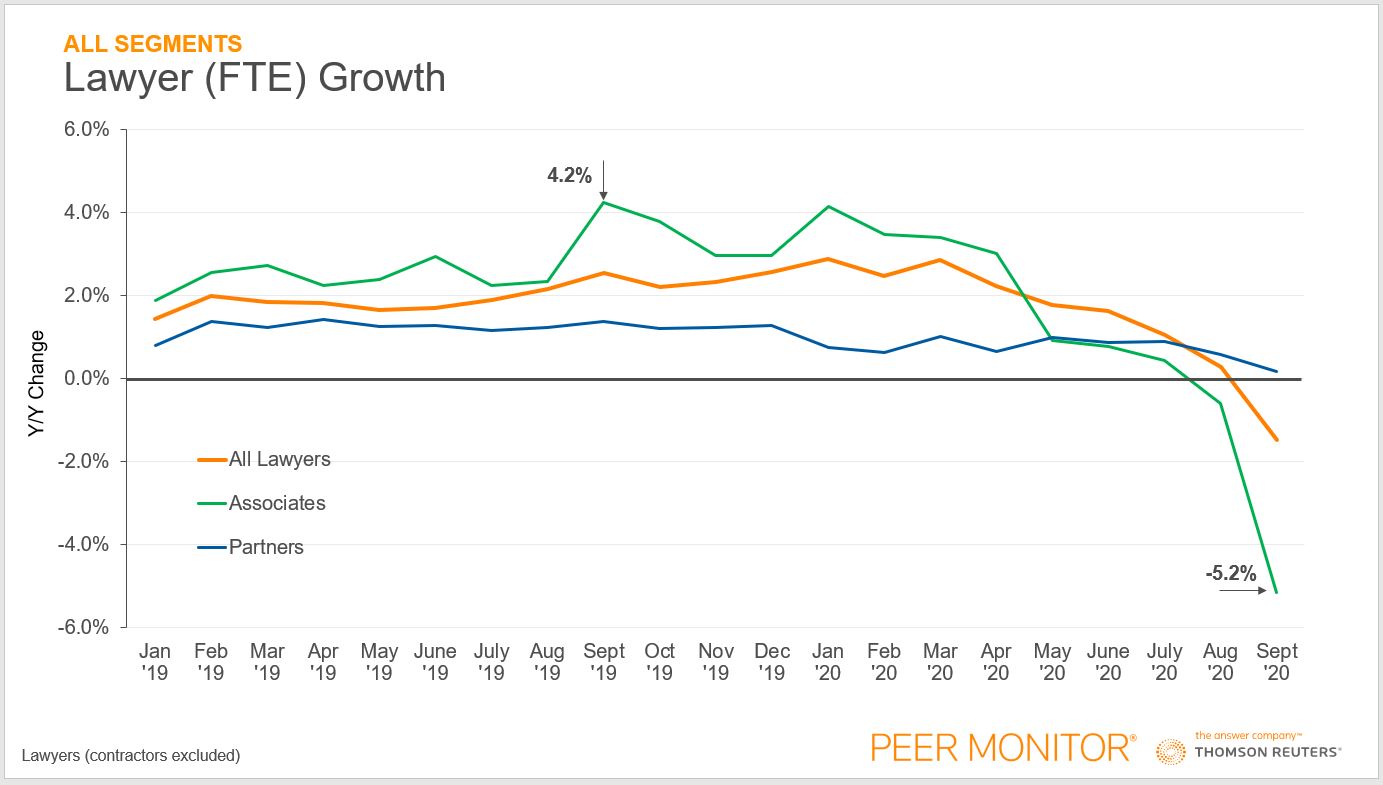Before Q3, the growth in associates was faster than the combination of all lawyer titles; then during the pandemic, the number of associates were reduced
The large law firm industry regained some footing in the third quarter of this year, despite an environment of low demand, owing to positive factors like high worked rates and reduced expenses.
These conflicting factors centralize behind a single force that allowed for 7-point rise in the Q3 Peer Monitor Economic Index (PMI), which ascended to 58.
The PMI’s relative improvement from Q2 first can be seen in demand, where average total hours worked fell 2.4% for the third quarter. This compared favorably to Q2, which saw a 5.9% contraction. While demand remained down (although to a lesser extent), law firm profitability metrics have been buoyed by other areas such as higher average rates, relatively well-maintained productivity levels, and implementation of cost-saving measures. All of these factors have one thing in common — they are related to reductions in the number of lawyers or full-time-equivalents (FTEs) by law firms.
As with most markets, the balance of supply and demand is crucial. For law firms, lawyers and their services are the supply, so when that level is reduced the maximum amount of work a firm can complete is reduced as well. With that being said, headcount reductions can function as a sort of addition by subtraction, in that reducing less-productive lawyers in times of demand shortfalls (as we are right now), keeps firm-wide productivity intact.
You can download a full copy of the Q3 2020 PMI report here.
That is to say, while productivity contracted by an average of 2.4% in Q3, the marked improvement from the 7.4% contraction seen in Q2 still provides great value to a firm’s bottom line in the short term. This can be seen in the corresponding decrease in average direct expense growth for Q3, which averaged only 1.1% growth, a 38-quarter low.
As average worked rates have risen over the past six months, much of that growth has not been driven by higher dollar values charged per hour across all fee earners, but instead has originated from a shift in workplace dynamics. As you can see in the chart below, the growth in the number of associates grew at a faster pace than the combination of all lawyer titles for 2019 and Q1 of 2020.
Then as the pandemic progressed, associates have been the primary target of headcount reductions at law firms, with this trend accelerating greatly in September. The decline in associate headcount has been so much so that the average law firm now employs fewer associate lawyers than it did in 2018, ceding all of the gains made over the preceding two years.

Partner staffing has also trended downward, but not at the pace of associates. The result has been that associates have become a smaller portion of the lawyer population in the average firm. Reducing hours priced at the average associate worked rate of $438, and replacing those with the $681 average partner worked rate has inflated the average worked rate of all timekeepers at firms across the market greatly.
At the beginning of the pandemic, with uncertainty at its highest, worked rates rose to 5.2% in Q2. This was because clients had increased levels of demand for advisory services from their most trusted partner. However, that peak faded slightly in monthly figures in July and August, but returned in September. Worked rates continue to rise and have again reached an all-time high of 5.4% growth in October, but this time it was not because of a spike in uncertainty caused by the virus, but rather because of the fundamental changes in staffing and leverage models within firms.
Law firms reacted quickly to the near-term effects that the COVID-19 pandemic forced upon them at the onset of March by reducing allied professional staff first, and by September’s end reducing their associate lawyers. This has greatly improved current profitability metrics for 2020 for many firms. Yet, what remains to be seen is the effect the now-thinner associate classes will have on leverage structure, succession planning, and future profit margins.






